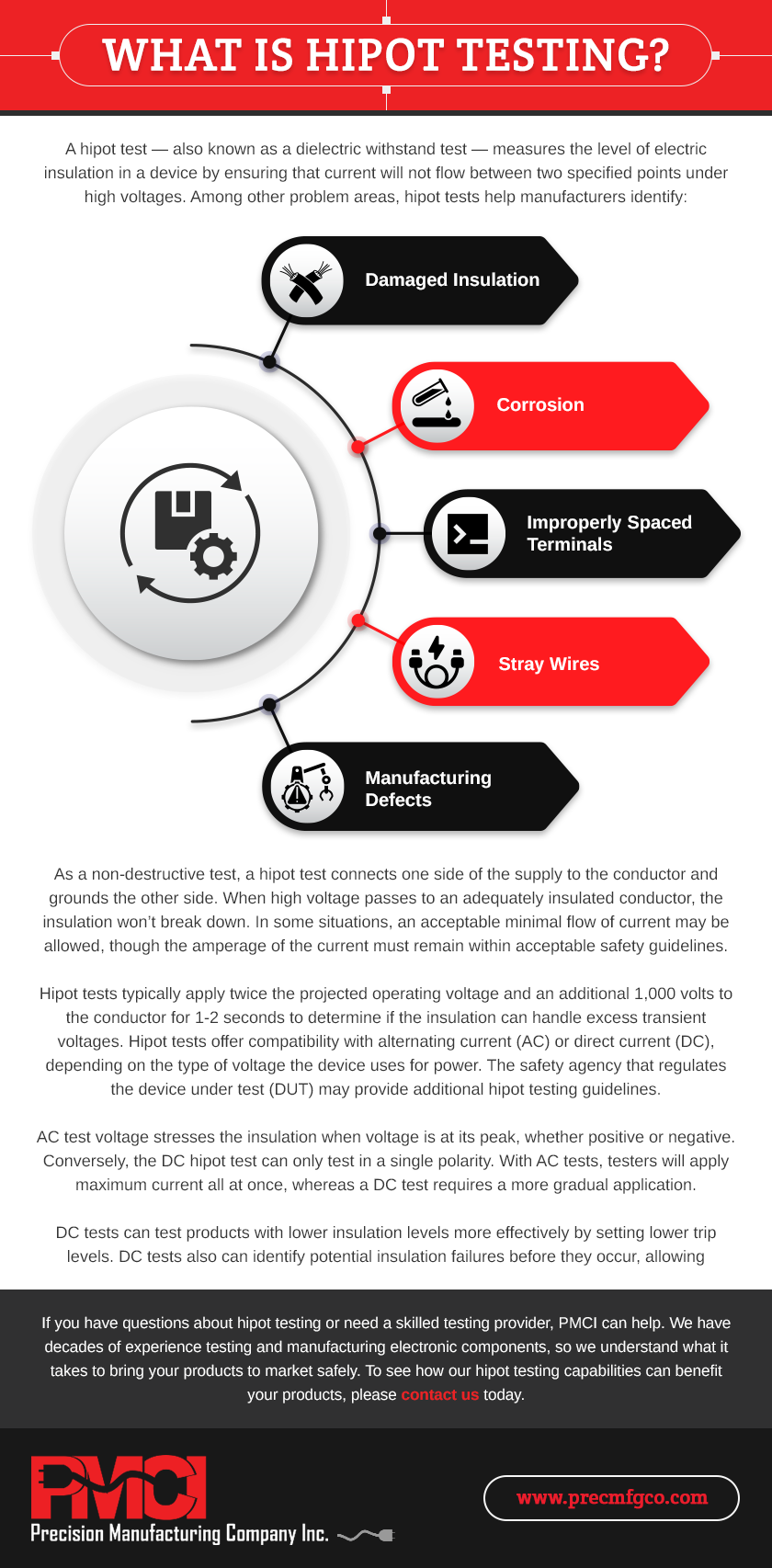Established in 1967, Precision Manufacturing Company, Inc. (PMCI) is a world-class wire harness provider offering design, engineering, and manufacturing services to customers across numerous industries. Our expertise in manufacturing electronics and electrical products includes high-potential (hipot) testing, a critical safety step for many electronic components before distribution. Hipot testing is an essential final production step for many types of goods, including circuit boards, electric motors, transformers, and more.
What is Hipot Testing?
 A hipot test — also known as a dielectric withstand test — measures the level of electric insulation in a device by ensuring that current will not flow between two specified points under high voltages. Among other problem areas, hipot tests help manufacturers identify:
A hipot test — also known as a dielectric withstand test — measures the level of electric insulation in a device by ensuring that current will not flow between two specified points under high voltages. Among other problem areas, hipot tests help manufacturers identify:
As a non-destructive test, a hipot test connects one side of the supply to the conductor and grounds the other side. When high voltage passes to an adequately insulated conductor, the insulation won’t break down. In some situations, an acceptable minimal flow of current may be allowed, though the amperage of the current must remain within acceptable safety guidelines.
Hipot tests typically apply twice the projected operating voltage and an additional 1,000 volts to the conductor for 1-2 seconds to determine if the insulation can handle excess transient voltages. Hipot tests offer compatibility with alternating current (AC) or direct current (DC), depending on the type of voltage the device uses for power. The safety agency that regulates the device under test (DUT) may provide additional hipot testing guidelines.
AC test voltage stresses the insulation when voltage is at its peak, whether positive or negative. Conversely, the DC hipot test can only test in a single polarity. With AC tests, testers will apply maximum current all at once, whereas a DC test requires a more gradual application.
DC tests can test products with lower insulation levels more effectively by setting lower trip levels. DC tests also can identify potential insulation failures before they occur, allowing manufacturers to salvage the DUT. DC tests can also more easily identify low dielectric resistance areas and mechanical damage that may affect the insulation.
Why is Hipot Testing Important?
Whether using AC or DC voltage, hipot testing allows manufacturers to ensure that finished electronics and electric-powered devices, such as appliances, mobile devices, and other products, can handle surges in voltage. These surges, known as transient over-voltages, can occur over low-voltage networks periodically, typically with durations measured in milliseconds.
Despite their brevity, transient over-voltages may cause severe equipment damage and even start fires under certain circumstances. Manufacturers may be held legally liable for the damages caused by devices without proper insulation. Legal repercussions aside, manufacturers want to avoid the bad publicity and lost revenue that can stem from defective devices.
As a result, electronic goods and electrically powered devices must undergo hipot testing before sale to avoid these risks. Given the use of high voltage, this testing method can pose risks to inexperienced testers. This risk factor makes it critical to use skilled and experienced testing providers.
If you have questions about hipot testing or need a skilled testing provider, PMCI can help. We have decades of experience testing and manufacturing electronic components, so we understand what it takes to bring your products to market safely. To see how our hipot testing capabilities can benefit your products, please contact us today.

Recent Comments